Marin says its Alpine Trail XR is aimed at “enduro-style riding and racing”, where, “travel and geometry matter most”.
It’s easy to spot the stretched-out geometry, relaxed head angle and burly build. Look closer at the spec sheet, though, and you may need to do a double take.
That’s because it’s jam-packed with great kit, yet still comes in at a scarcely believable price (certainly when compared to its closest rivals).
So, is the Alpine Trail XR the bargain of the year, or too good to be true? Read on to find out.
Marin Alpine Trail XR frame and suspension details
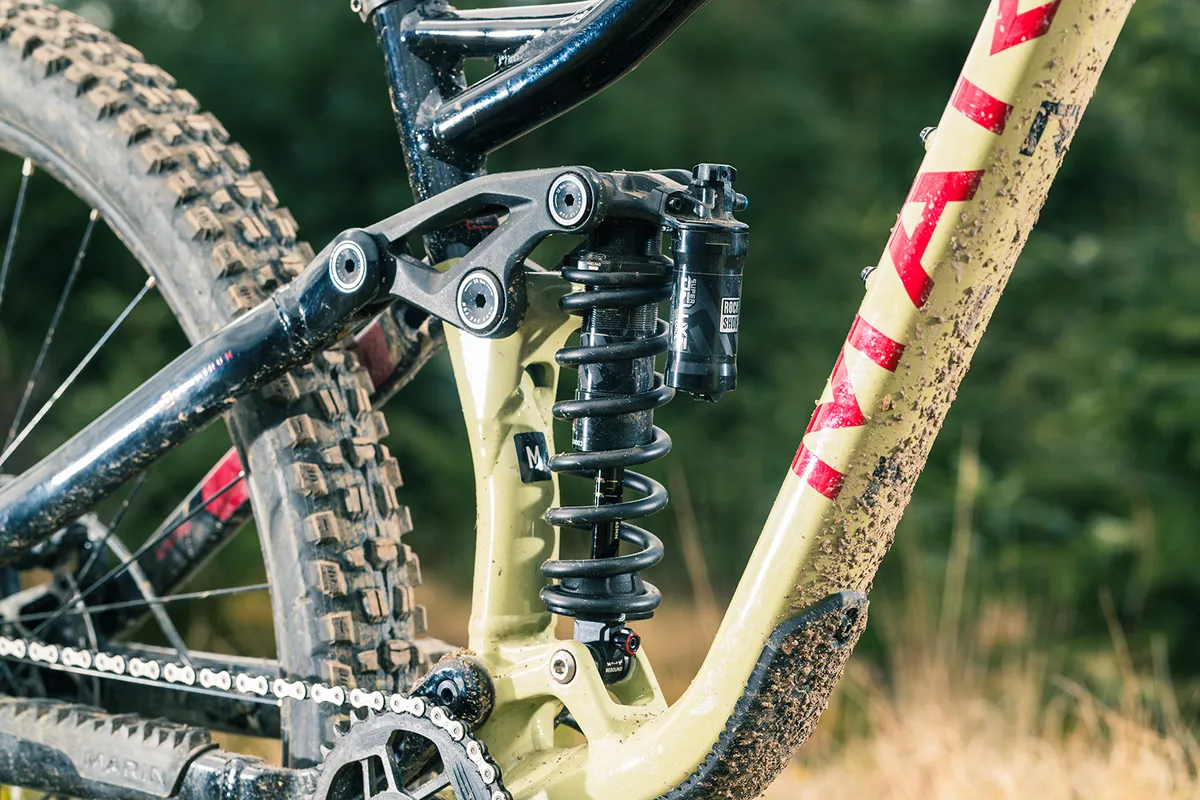
The Alpine Trail XR is made using Marin’s Series 4 aluminium. Its fairly traditional layout is a far cry from the rather radical Mount Vision we rode back in 2019.
The tubes are subtly shaped and curved, with additional reinforcement added to the top and seat tube junction, while the top and down tube meet nice and early in a bid to help bolster strength at the head tube junction.
There’s no seatstay bridge, ensuring masses of mud clearance (and this also allows Marin to use short chainstays).
Driving the rear shock is a one-piece forged rocker link that's designed to be both stiff and strong, with the aim of ridding any unwanted flex from the suspension system and keeping the back end of the bike working as smoothly as possible.
When it comes to suspension travel, the Alpine Travel XR boasts 150mm. That might not sound a lot relative to some other enduro bikes.
We’ll assume it’s a case of quality over quantity (and let’s not forget, Nico Vouilloz, 10 times World Downhill champion, regularly opted to use shorter-travel bikes compared with his competitors to win some massive races, so it’s clearly something that can work if executed properly).
That 150mm of rear-wheel travel is delivered by Marin’s ‘MultiTrac’ suspension platform. This consists of a single pivot with a linkage (the seatstays and rocker link) driving the shock.
All frames get bottle cage mounts (more on these later), internal cable routing and a decent amount of integrated frame protection in all the right places.
Marin Alpine Trail XR geometry

Marin didn’t hold back when it came to the Alpine Trail XR’s proportions.
You only need to look towards the front of the bike to see just how relaxed the head angle is. The fact you can spot this from a cursory glance says a lot. At 62.5 degrees, it certainly makes the Alpine Trail XR one of the more extreme bikes out there.
In a similar vein, the 78.5-degree seat angle (measured at my preferred pedalling height) is one of the steepest compared to its counterparts, suggesting a comfy seated position when winching up steep climbs.
That raked-out head angle, along with the 455mm of reach, contribute to a lengthy 810mm front centre (the horizontal measurement from the centre of the bottom bracket to the centre of the front axle), which will no doubt contribute to stability at higher speeds.
At 335mm off the floor, the bottom bracket is really quite low. This comes with pros and cons. The main negative is that the lower the bottom bracket, the more common it is to clout your pedals on the ground or rocks.
Arguably the biggest plus is that it lowers your centre of mass and helps the bike feel more confident through the turns.
Another measurement of note is the rear centre, otherwise known as the chainstay length. Marin has opted to keep the back end of the Alpine Trail XR seriously compact (not the easiest thing to do when designing a bike around 29in wheels).
The 430mm rear centre is shorter than many other bikes with similar intentions. While this should work well for smaller riders on the more compact frame sizes, taller riders on the bigger frames may find their weight too far over the rear wheel at times (this is a large part of the reason some brands will now grow the chainstay measurement as frame size increases).
Seat tube lengths are really compact too (just 400mm on the size medium tested here).
That means there’s plenty of scope to use a long-travel dropper post, and you shouldn’t have any issues with the saddle getting in your way once it’s fully dropped.
It also gives riders the option to jump up a frame size if they’re straddling sizes or just looking for a bigger, more stable bike.
| | S | M | L | XL |
|---|---|---|---|---|
| Seat angle (degrees) | 78 | 78 | 78 | 78 |
| Head angle (degrees) | 63.5 | 63.5 | 63.5 | 63.5 |
| Chainstay (mm) | 430 | 430 | 430 | 430 |
| Seat tube (mm) | 390 | 400 | 425 | 430 |
| Top tube (mm) | 562 | 589 | 615 | 652 |
| Head tube (mm) | 100 | 110 | 115 | 130 |
| Fork offset (mm) | 44 | 44 | 44 | 44 |
| Bottom bracket drop (mm) | 35 | 35 | 35 | 35 |
| Bottom bracket height (mm) | 342 | 342 | 342 | 342 |
| Wheelbase (mm) | 1,199 | 1,229 | 1,256 | 1,297 |
| Standover (mm) | 714 | 716 | 732 | 734 |
| Stack (mm) | 619 | 628 | 632 | 643 |
| Reach (mm) | 430 | 455 | 480 | 515 |
Marin Alpine Trail XR specifications

Easily the most noteworthy parts that jump out from the spec sheet have to be the RockShox Lyrik Ultimate fork and Super Deluxe Coil Ultimate RCT shock.
When you consider bikes (also with aluminium frames) that cost considerably more than the Trail Alpine XR don’t use this level of damper, it’s impressive to see it included on such a competitively priced machine.
The fork uses the Charger 2.1 RC2 damper, which offers external adjustment of the high- and low-speed compression damping, along with rebound damping. Air pressure in the spring is easy to alter and tuning the progressivity of the spring is taken care of using volume spacers that can be fitted and removed quickly.
At the rear, Marin has opted to spec a coil shock, clearly indicating that the brand has developed the Alpine Trail XR to be progressive enough to handle one. The choice should deliver a very sensitive initial part of the travel and with it, plenty of much-needed traction.
Externally, the Super Deluxe Coil RCT offers rebound and low-speed compression-damping adjustment. There’s also a low-speed compression lever to help firm the shock up for climbing.
The gearing is something of a mixed affair. A Shimano XT 12-speed rear derailleur works alongside an SLX 10-51t cassette and SLX shifter, all of which are driven by FSA Gradient cranks.
Shimano also provides the M4100 four-piston brakes. These feature the cheaper, non-Servo Wave-equipped levers.

There’s a decent smattering of own-brand Marin equipment, too, including the 35mm-diameter bar, stem, rims, saddle and grips, all of which are finished nicely and look like quality bits of kit.
Wrapping those Marin rims are some of my favourite mountain bike tyres. A Maxxis Assegai adorns the front and rear, with a lighter EXO+ casing up front and tougher DoubleDown option at the back. Oddly, Marin delivers the bike with a 3C MaxxTerra tyre up front and a slower rolling 3C MaxxGrip compound at the rear.
I’d say it’s worth swapping them around if you can.
Marin Alpine Trail XR ride impressions
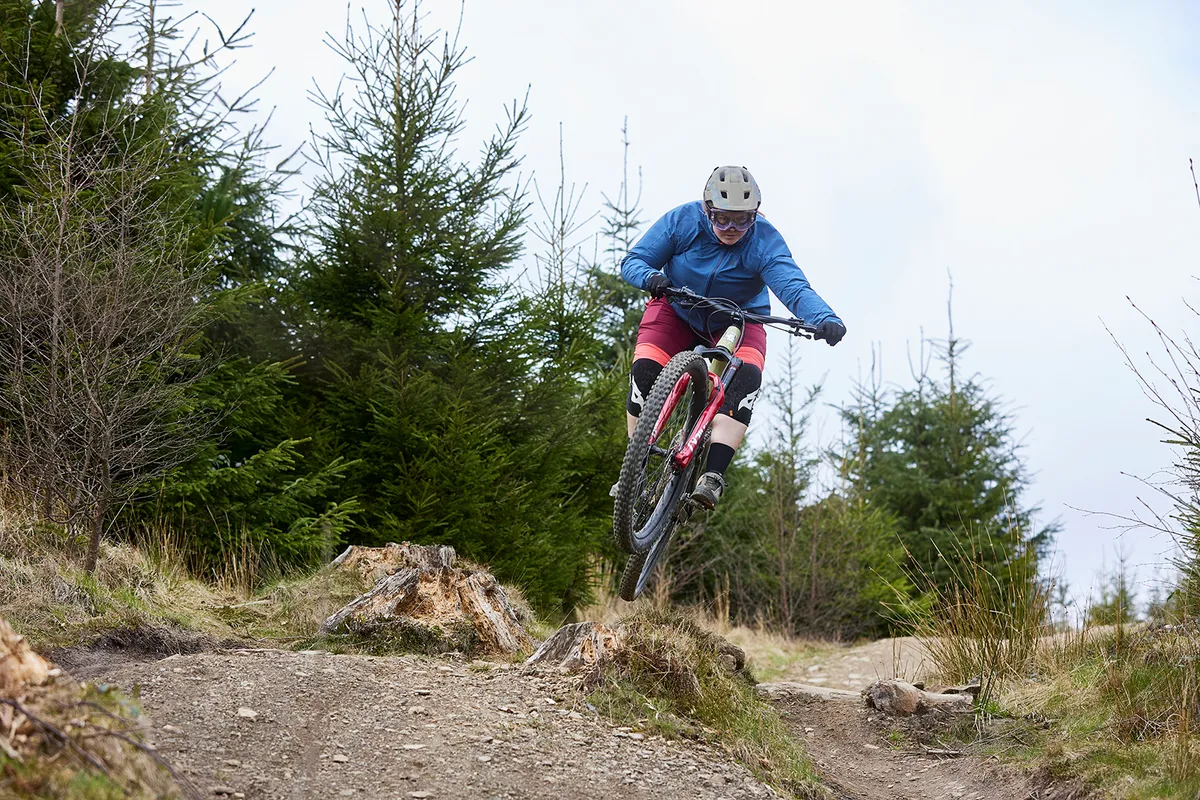
Getting to grips with a bike and really uncovering how it performs means riding a lot of different trails.
As the Alpine Trail XR is designed for ‘enduro-style’ riding, I rode it on a wide variety of trails, spanning from steep natural tracks covered in rocks and roots, to the higher speeds and rougher rock gardens found at bike parks.
Setting up the Marin Alpine Trail XR
While setting up the 160mm-travel RockShox Lyrik Ultimate – a fork I’m very familiar with – proved straightforward enough, I had to spend a little longer working on the Super Deluxe coil shock at the rear.
Marin supplies the bike with a 350lb spring as standard. After some trial and error, I ended up switching over to a 300lb spring. This gave me 30 per cent sag. I ran the rebound damping on the shock fully open and had 8 clicks (from fully closed) of low-speed compression damping wound on.
After dialling in the shock, which took a good few rides and some tinkering (it should be said, switching coil springs is a far more time-consuming affair than tweaking air pressures in an air-sprung shock), I did have to alter the fork settings slightly.
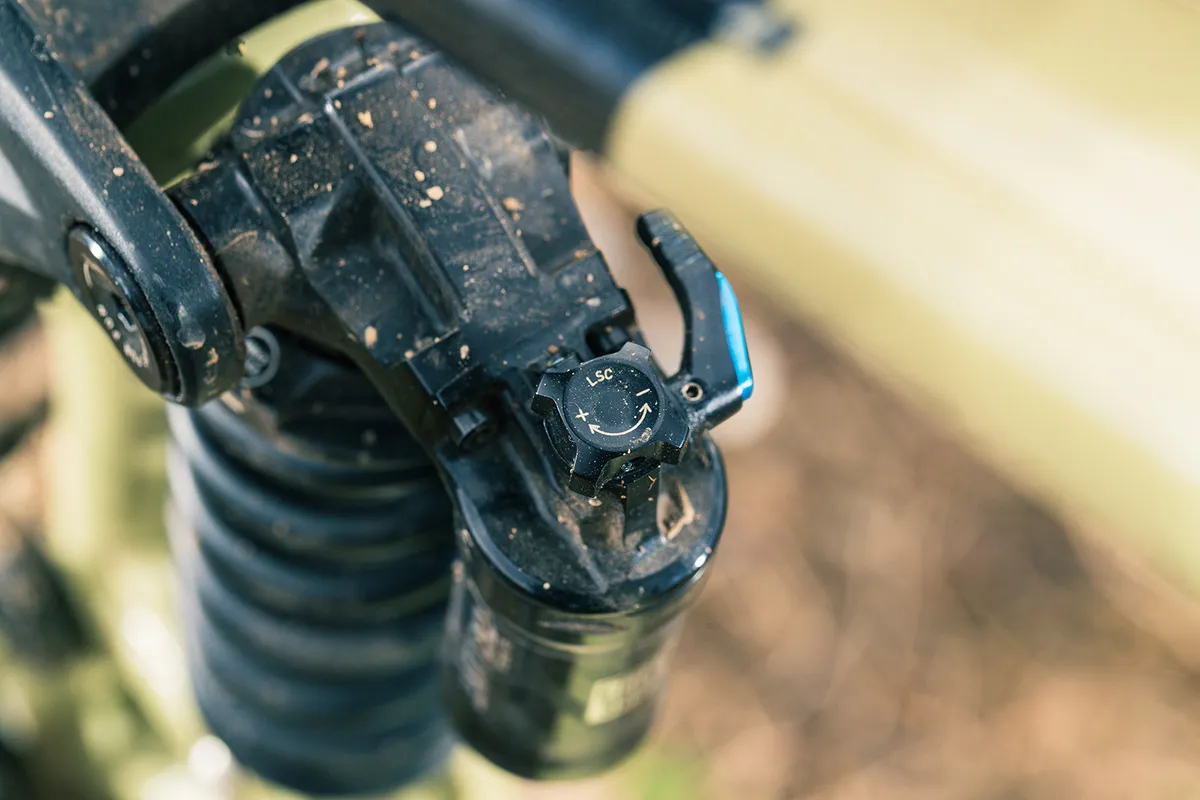
In the end, my settings for the Lyrik were 70psi in the spring (and two volume spacers that Marin supplies), with 16 clicks of low-speed compression, the high-speed compression dial fully open and 11 clicks of rebound damping, again, all taken from fully closed.
All in, my medium test bike weighed 16.25kg without pedals.
Marin Alpine Trail XR climbing performance
As predicted, the steep seat angle of the Alpine Trail XR encourages a comfy, quite upright position on the bike. Your hips sit over, not behind the bottom bracket, which makes for comfortable and efficient pedal strokes.
The effective top tube is a shade under 590mm, so it isn’t the roomiest bike when seated, but I never felt particularly uncomfortable when riding uphill in the saddle.

No, the Marin isn’t the sprightliest climber. That’s partly down to the 16.25kg weight but also the drag created by the 3C MaxxGrip compound used on the rear tyre. As I mentioned above, swapping the front and rear tyres will help a little here.
The suspension does hunker down a little under power, but remains relatively calm as you spin the cranks. Should you need to firm things up, reaching the shock’s low-speed compression lever is easy enough.
The Marin Alpine Trail XR might leave you thirsty
After all of that climbing, you’re left gagging for a drink. That’s not a problem if you’re riding the large or extra-large frames (as confirmed by Alex Evans, one of our technical editors, who has a size-large Alpine Trail XR), but if you’re a smaller rider, you may have to go thirsty.
Why, you ask? Well, when I tried to fit a bottle cage and bottle to my medium test bike, I quickly realised that once the bottle was in place, the shock’s reservoir fouled on the bottle when compressed. I shunted the bottle cage as far up as it would feasibly go on the mounts, but the shock still hit the bottle, so I had to remove the bottle and cage.
Marin Alpine Trail XR descending performance
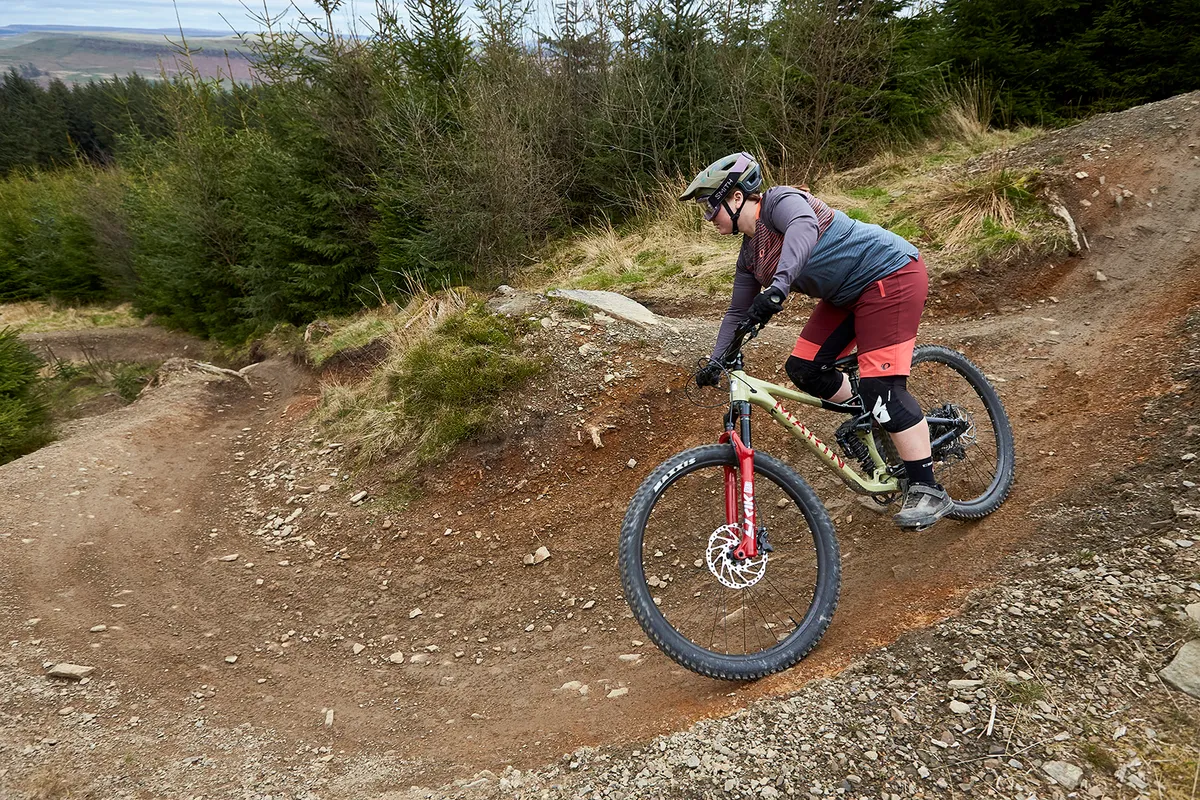
From the get-go, wind the power on and the Alpine Trail XR feels rapid. That’s both in terms of how efficient things feel through the reasonably stiff frame as you pile on the power, but also how stable it feels once the pace has picked up.
The short back end and taut frame also make it an easy bike to flick about or loft the front wheel into the air with little effort from the rider.
That means chucking it around and making shapes as you work your way down the trail comes really naturally to the Alpine Trail XR, and you don’t need to expend too much extra energy if you’re keen on bouncing your way down the trail getting sideways at every opportunity.
Through high-speed, loose turns, there were occasions when, thanks in part to the short back end, I found myself working a little harder to keep my weight over the front wheel and the front tyre gripping.
These instances were few and far between for me on the medium frame, but taller riders on bigger bikes may notice this more frequently. And that’s not to say the short back end holds the Marin back, but a slightly longer back end (maybe just on the bigger frames) would simply make it even better.
Upgrade potential
The relaxed head angle, low bottom bracket and lengthy front centre all add up to make a seriously confident descender, but there’s still room for improvement.
That’s not down to the geometry, because it feels as though Marin has done a good job here. It's more the spec, which could do with some small upgrades.
While the Shimano M4100 brakes offer a punchy initial bite, they lack the grunt of their pricier counterparts on longer drags or when trying to cull speed quickly.
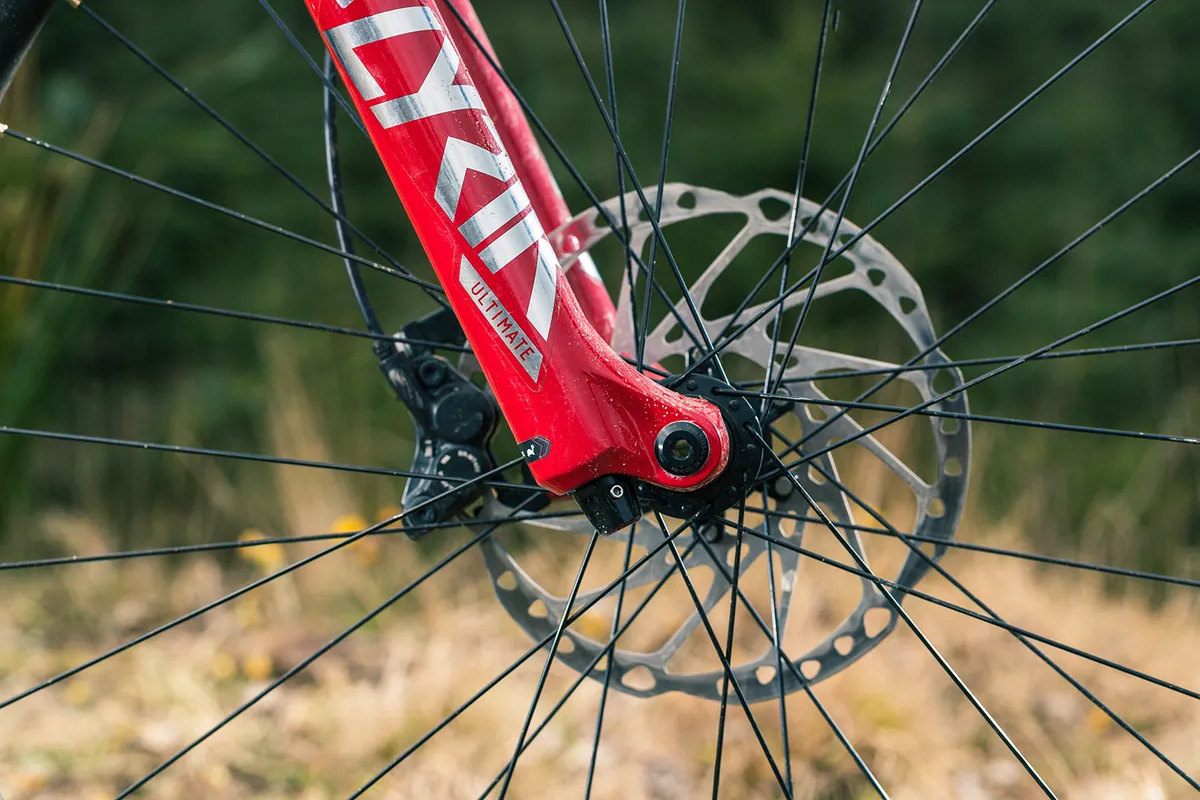
The long levers are comfy enough, but lack the light feel of the slightly more expensive M6120 numbers found on peers such as the Cannondale Jekyll 2, which I also reviewed as part of this test.
I’d happily downgrade the XT/SLX drivetrain for 12-speed Deore gearing if it meant Marin could spec the M6120 four-piston brakes, which feature Servo Wave technology in the levers.
If that’s too costly, even switching to a bigger rear rotor (180mm to 203mm) would help a bit.
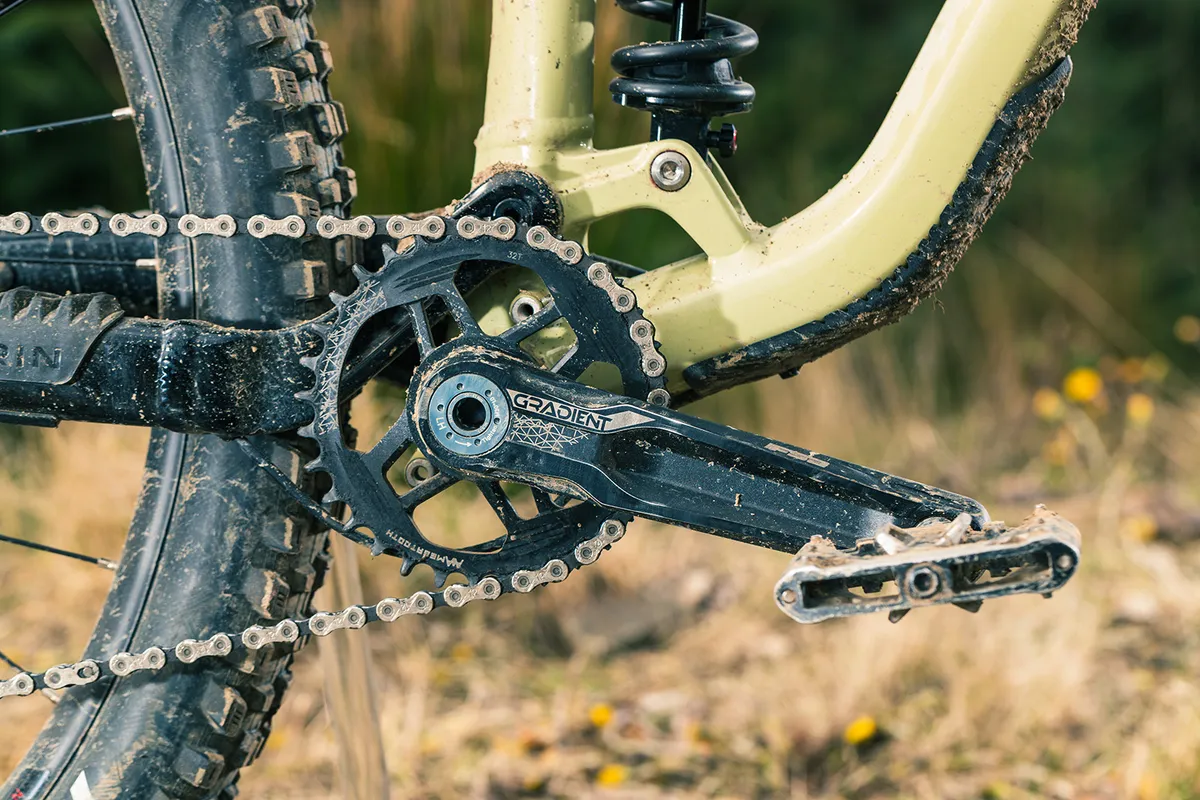
The other component of note is the 35mm-diameter bars. These feel overly stiff for my 68kg weight and led to an unwanted amount of feedback through my hands on rougher trails.
Knowing the Lyrik fork offers a very forgiving feel, I switched the bar and stem out for a 31.8mm alloy bar to see if it made a difference to comfort. On the same track, things felt a little easier on my hands with the thinner-diameter bar in place.
I need to make clear that these are nagging quibbles, and certainly don’t make or break the Alpine Trail XR’s ride experience. These suggestions would simply elevate the bike’s performance to a higher level.
Diamond in the rough

So, the Alpine Trail XR isn’t perfect, and there’s room for improvement when it comes to the spec. But still, there’s no getting away from all the positives of this bike. It has a cheeky character and penchant for speed that's impossible to dispute.
The feel through the bars and pedals may be a little raw compared to some of the bigger-travel bikes in this category.
Let’s not forget the Alpine Trail XR is equipped with 150mm – certainly towards the lower end of the enduro travel spectrum, if such a thing exists – which means it can’t smooth the big impacts in quite the same way, but it certainly has a good go.
Just as expected, the supple initial part of the shock’s stroke does a fine job of keeping the tyre connected to the dirt when it matters most, but there’s support through the middle part of the travel when you need it, too.
On really big hits, I never felt as if I was clanking through the final third of the travel. Instead, things feel controlled and smooth when you do call upon those final few millimetres.
All in all, the Alpine Trail XR is less like an ultra-refined supercar and more akin to a rough-and-ready muscle car. There’s stability and composure – without ever dulling the fun factor – and masses of potential on pretty much any trail.
How does the Marin Alpine Trail XR compare?
In terms of travel, the Marin sits closest to the Santa Cruz Bronson C R, but it’s far more of a bruiser than its carbon-framed counterpart. Likewise, there’s a similarly playful and supportive feel to the Propain Tyee AL 29. However, the Marin trumps the Tyee when it comes to all-out speed.
At the very pointy end of this category, comparing the Alpine Trail XR with the Giga or G-180 RS MX starts to highlight chinks in its armour. Both the Whyte and Nukeproof – which have more travel at the front and rear than the Marin – feel more composed and less frantic when barrelling through rock gardens at speed.
Marin Alpine Trail XR bottom line

Aside from being masses of fun to ride, the Marin Alpine Trail XR is a seriously capable bike.
More than that, though, the spec on offer is really impressive for the cash. Okay, there are some small(ish) potential changes that could be made to really lift performance, but there’s no getting away from just how great this bike is to ride when you open up the taps.
Enduro Bike of the Year 2022 | How we tested
Designing a high-performance enduro bike is all about balance.
While there’s no denying these bikes need to descend with the confidence and poise of a full-blown downhill bike, they still need to be pedalled back up to the top of the hill.
But, more than that, they also need to be built to last with components that can take a serious beating.
To be crowned as the best enduro bike on test, we were looking for a bike that felt pleasant enough on the climbs (no enduro bike will ever be a cross country-like mountain goat!) and easy to ride fast when pointed back downhill.
Testing the bikes required a serious amount of riding over a 12-week period. The terrain needed to be varied, too. Testing included everything from steep, natural trails covered in roots and peppered with rocks and mud, through to faster, high-speed bike park tracks with wheel-destroying rock gardens and chunky jumps.
We rode all of the bikes on test back-to-back to pin down the differences and mixed up the order in which we rode the bikes to see just how each machine felt when we were fresh – and not so fresh.
Our 2022 Enduro Bike of the Year contenders are:
- Cannondale Jekyll 2
- Canyon Torque CF8
- GT Force Carbon Pro
- Marin Alpine Trail XR
- Nukeproof Giga 297 Carbon Elite
- Propain Tyee AL 29 Performance
- Santa Cruz Bronson C R
- Whyte G-180 RS MX
Thanks to…
Thanks to our sponsors MET Helmets, Bluegrass Protection and BikePark Wales for their support in making Bike of the Year happen.
Product
| Brand | marin |
| Price | 5499.00 AUD,3955.00 EUR,3475.00 GBP,3999.00 USD |
| Weight | 16.2500, KILOGRAM (M) - without pedals |
Features
| Fork | RockShox Lyrik Ultimate, 160mm (6.3in) travel |
| br_stem | Marin CNC, 35mm |
| br_chain | KMC X-12 |
| br_frame | Series 4 6061 aluminium, 150mm (5.9in) travel |
| Tyres | Maxxis Assegai 3C MaxxTerra EXO+ 29x2.5in (fr)/Maxxis Assegai 3C MaxxGrip DD 29x2.4in (r) |
| br_brakes | Shimano BL M4100 (203mm/180mm rotors) |
| br_cranks | FSA Gradient |
| br_saddle | Marin Speed Concept |
| br_wheels | Marin Aluminium Double Wall rims on Shimano MT410B (fr) and MT510B (r) hubs |
| br_headset | FSA |
| br_shifter | Shimano SLX |
| br_cassette | Shimano SLX 10-51t |
| br_seatpost | X-Fusion Manic, 150mm |
| br_gripsTape | Marin Lock-On |
| br_handlebar | Marin 35 Alloy, 780mm |
| br_rearShock | RockShox Super Deluxe RCT Coil |
| br_bottomBracket | FSA MegaEVO |
| br_availableSizes | S, M, L, XL |
| br_rearDerailleur | Shimano XT |
